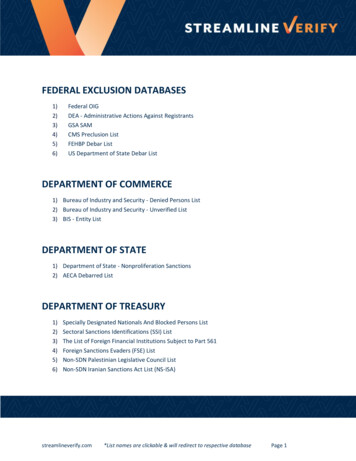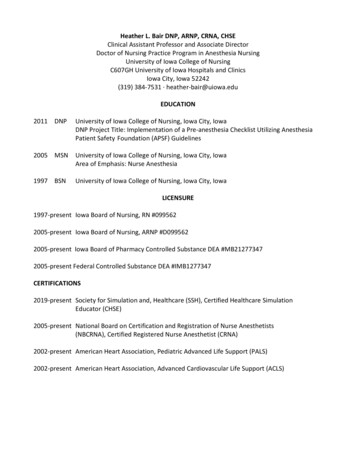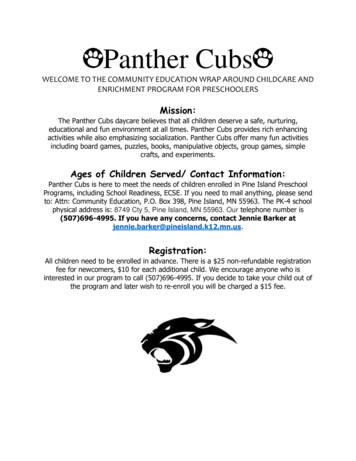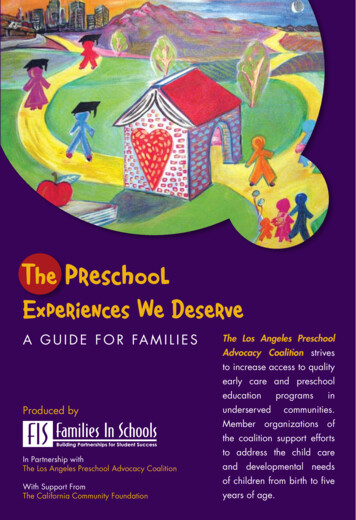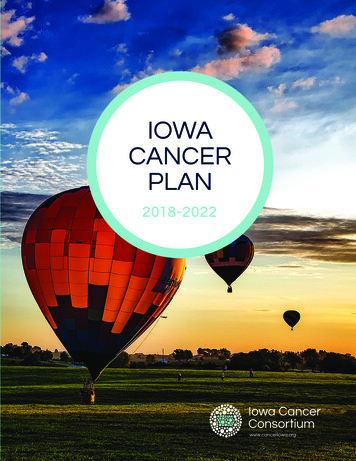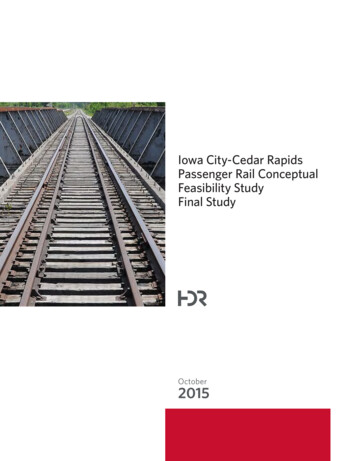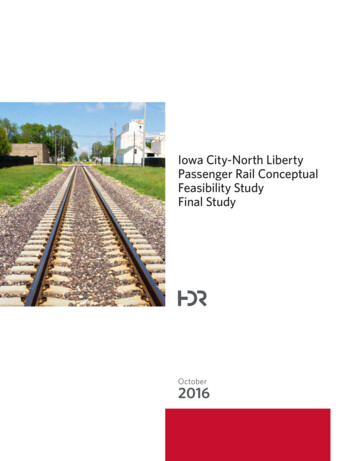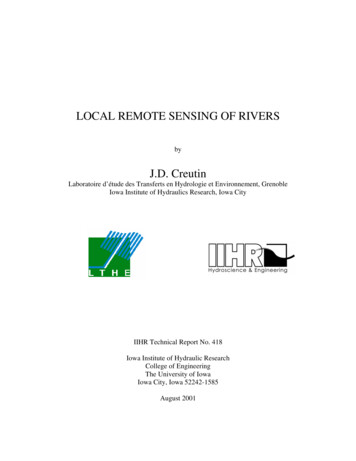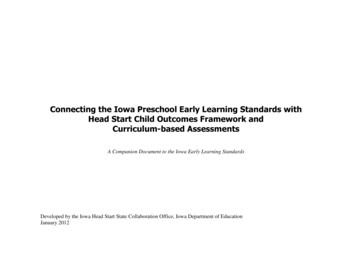
Transcription
Connecting the Iowa Preschool Early Learning Standards withHead Start Child Outcomes Framework andCurriculum-based AssessmentsA Companion Document to the Iowa Early Learning StandardsDeveloped by the Iowa Head Start State Collaboration Office, Iowa Department of EducationJanuary 2012
Connecting the Iowa Early Learning Standards with Head Start Child Outcomes Framework and Child AssessmentsPage 2Connecting the Iowa Preschool Early Learning Standards with Head Start Child OutcomesFramework and Curriculum-based AssessmentsIntroductionMaking use Iowa’s Early Learning Standards (IELS) is essential if these standards are to be of any value at all. But makingeffective and appropriate use of them is equally important to ensure they help early care and education providers make gooddecisions about curriculum and assessment and to encourage the thoughtful applications of these standards consistent withour best knowledge in how children grow and learn. The goal is to have the standards, curriculum and assessment align. Atthe same time, we remain sensitive to how children grow and develop in unique ways. Developmentally appropriate practicesmust be our guide in designing any educational service for young children.When we implement standards, they should be guidelines for how we design our curriculum and classroom activities. Theyare not the activities nor the curriculum itself. This document helps us make the connection between our learning goals andwhat we actually do with children in the classroom.This document helps educators begin that consideration by linking the Iowa Preschool Early Learning Standards with the“Head Start Child Development and Early Learning Framework.” It only addresses the preschool standards which are the lastsix (Standards 7-12). The new Head Start framework expanded and revised the older Head Start Outcomes framework whichwas originally released in 2000. This older document was a key reference document when the Iowa Early Learning Standardswere developed. But the revised framework still is closely aligned to the early learning standards. Head Start published inSeptember, 2003, The Head Start Leaders Guide To Positive Child Outcomes, that provides a comprehensive set of effectiveteaching strategies to foster children’s progress toward a broad range of key early learning and development goals asarticulated in the “Head Start Child Outcomes Framework.” (This document is available FINAL4c.pdf.) The connections established in the document betweenthe Framework and the Iowa Preschool Early Learning Standards will also help Head Start grantees show how their activitiesalign with the Iowa voluntary standards as they seek to design child outcomes along the lines of the Framework.This document also links the Iowa Preschool Early Learning Standards to the curriculum-based assessment frameworks ofthree popular early childhood curriculum/assessment systems: High/Scope, Creative Curriculum GOLD, and the WorkSampling System. These systems include a set of organized learning objectives, activities that relate to these objectives andan accompanying child assessment tool. Using the linkages in this document, teachers and program administrators can designDeveloped by the Iowa Head Start Collaboration Office, Iowa Department of Education· January 2012Page 2
Connecting the Iowa Early Learning Standards with Head Start Child Outcomes Framework and Child AssessmentsPage 3their learning with all these elements in mind and with a clear view on how their efforts relate to the Iowa Early LearningStandards, especially now that many are using the Creative Curriculum GOLD as their primary curriculum-basedassessment. They can determine if their current chosen curriculum covers all the IELS areas and standards. They can use it asa guide for making a list of what they want children to learn, the activities they plan to do that support awareness andexploration by children of the content in the standards and a method to determine if children are learning what theircurriculum system is supposed to be teaching.AcknowledgementsSpecial thanks for developing this document goes to Brenda Spurgeon, Cathy Swackhamer, Kim Young-Kent, Mary JoMadvig and Rosemary Geiken.Tom Rendon, CoordinatorIowa Head Start State Collaboration OfficeDeveloped by the Iowa Head Start Collaboration Office, Iowa Department of Education· January 2012Page 3
Connecting the Iowa Early Learning Standards with Head Start Child Outcomes Framework and Child AssessmentsPage 4Area 7: Physical Well-Being and Motor DevelopmentIowa Preschool EarlyLearning Standard7.1 Healthy andSafe LivingChildren understandhealthy and safe livingpractices.The Head Start ChildDevelopment and EarlyLearning Framework1DOMAIN: PhysicalDevelopment & HealthDOMAIN ELEMENT:Health Knowledge &Practice: The understandingof healthy and safe habitsand practicing healthyhabits.Curriculum-based AssessmentsHigh/Scope ChildObservationCategory2I. InitiativeD. Taking care ofpersonal needsThe Creative Curriculum GOLDSOCIAL/EMOTIONALDEVELOPMENT: Objective 1:Regulates own emotions andbehaviorsDimension c. Takes careof own needsappropriatelyIndicator 6.Demonstratesconfidence inmeeting ownneedsIndicator 8.Takesresponsibility forown well-being.Work SamplingSystem CurriculumAreas3PHYSICALDEVELOPMENT ANDHEALTH: Personal healthand safetyPerforms some selfcare tasksindependentlyFollows basic healthand safety rules.SOCIAL STUDIES:Objective 29:Demonstratesknowledge about selfDeveloped by the Iowa Head Start Collaboration Office, Iowa Department of Education· January 2012Page 4
Connecting the Iowa Early Learning Standards with Head Start Child Outcomes Framework and Child AssessmentsPage 5Iowa Preschool EarlyLearning Standard7.2 Play andSensesChildren engage in playto learn.Head Start Child OutcomesFrameworkHigh/ScopeDOMAIN: Science Knowledge& SkillsDOMAIN ELEMENT:Scientific Skills & Method:The skills to observe andcollect information and use itto ask questions, predict,explain, and draw conclusions.DOMAIN: Approaches toLearningDOMAIN ELEMENT:Initiative and Curiosity: Aninterest in varied topics andactivities, desire to learn,creativeness, andindependence in learning.DOMAIN: PhysicalDevelopment & HealthDOMAIN ELEMENT: GrossMotor Skills: The control oflarge muscles for movement,navigation, and balance.Developed by the Iowa Head Start Collaboration Office, Iowa Department of EducationCreative CurriculumWork SamplingSOCIAL STUDIES:Objective 24. Uses scientificinquiry skills.PHYSICALDEVELOPMENT:Objective 5. Demonstratesbalancing skillsCOGNITIVEDEVELOPMENT:Objective 11 Demonstratespositive approaches tolearningDimension d. Showscuriosity and motivationIndicator 6. Showseagerness to learnabout a variety oftopics and ideas· January 2012Page 5
Connecting the Iowa Early Learning Standards with Head Start Child Outcomes Framework and Child AssessmentsPage 6Iowa Preschool EarlyLearning Standard7.3 LargeMotorDevelopmentChildren develop largemotor skillsHead Start Child OutcomesFrameworkDOMAIN: PhysicalDevelopment & HealthDOMAIN ELEMENT: GrossMotor Skills: The control oflarge muscles for movement,navigation, and balance.High/ScopeIV. Movementand MusicChildren develop finemotor skills.DOMAIN: PhysicalDevelopment & HealthDOMAIN ELEMENT: FineMotor Skills: The control ofsmall muscles for such purposesas using utensils, self-care,building, and exploring.DOMAIN: LiteracyKnowledge & SkillsDOMAIN ELEMENT: EarlyWriting: The familiarity withwriting implements,conventions, and emerging skillsto communicate through writtenrepresentations, symbols, andletters.PHYSICAL DEVELOPMENTObjective 4. Demonstratestraveling skillsIndicator 6. Movespurposefully fromplace to place withcontrolObjective 5. Demonstratesbalancing skillsIndicator 6. Sustainsbalance during simplemovement experiencesL. Moving in variouswaysM. Moving withobjectsDOMAIN ELEMENT:Physical Health StatusThe maintenance of healthy andage appropriate physical wellbeing.7.4 Fine MotorDevelopmentCreative CurriculumIV. Movementand MusicObjective 6. Demonstrates grossmotor manipulative skillsIndicator 6.Manipulates balls orsimilar objects withflexible bodymovementPHYSICAL DEVELOPMENTL. Moving invarious waysM. Moving withobjectsDeveloped by the Iowa Head Start Collaboration Office, Iowa Department of EducationObjective 7: Demonstratesfine-motor strength andcoordinationDimension a. Uses fingersand handsIndicator 6. Usesrefined wrist andfinger movementsWork SamplingPHYSICAL DEVELOPMENTAND HEALTH: Gross MotorDevelopmentMoves with some balanceand control.Coordinates movementsto perform simple tasks.PHYSICAL DEVELOPMENTAND HEALTH: Fine MotorDevelopmentUses strength and controlto perform simple tasks.Uses eye-handcoordination to performtasksShows beginning controlof writing, drawing andart tools.Dimension b. Uses writingand drawing toolsIndicator 6. Holdsdrawing andwriting tools byusing a three-pointfinger grip but mayhold the instrumenttoo close to one end· January 2012Page 6
Connecting the Iowa Early Learning Standards with Head Start Child Outcomes Framework and Child AssessmentsPage 7Area 8: Approaches toward LearningIowa Preschool EarlyLearning Standard8.1 Curiosity andInitiativeChildren expresscuriosity, interest, andinitiative in exploring theenvironment, engaging inexperiences, and learningnew skills.Head Start Child OutcomesFrameworkDOMAIN: Approaches toLearningDOMAIN ELEMENT:Initiative & Curiosity: Aninterest in varied topics andactivities, desire to learn,creativeness, andindependence in learning.Curriculum-based AssessmentsHigh/Scope Child ObservationCategoryI. InitiativeA. Making choices andplansC. Initiating playD. Taking care ofpersonal needsDOMAIN: Social & EmotionalDevelopmentDOMAIN ELEMENT:Self-concept & Self-Efficacy:The perception that one iscapable of successfully makingdecisions, accomplishing tasks,and meeting goals.Developed by the Iowa Head Start Collaboration Office, Iowa Department of EducationTeaching Strategies GOLDCOGNITIVE DEVELOPMENTObjective 11:Demonstrates positiveapproaches to learningWork SamplingSystem CurriculumAreasPERSONAL AND SOCIALDEVELOPMENT:Approaches to LearningShows eagerness andcuriosity as a learner.Dimension d. Showscuriosity and motivationIndicator 6.Shows eagernessto learn about avariety of topicsand ideasDimension e. Showsflexibility andinventiveness in thinkingIndicator 6.Changes plans ifa better idea isthought of orproposed· January 2012Page 7
Connecting the Iowa Early Learning Standards with Head Start Child Outcomes Framework and Child AssessmentsPage 8Iowa Preschool EarlyLearning StandardHead Start Child OutcomesFramework8.2 Engagementand PersistenceDOMAIN: Approaches toLearningDOMAIN ELEMENT:Persistence & Attentiveness:The ability to begin and finishactivities with persistence andattention.Children purposefullychoose and persist inexperiences and activities.High/ScopeDeveloped by the Iowa Head Start Collaboration Office, Iowa Department of EducationCreative CurriculumCOGNITIVE DEVELOPMENTObjective 11Demonstrates positiveapproaches to learningDimension b. PersistsIndicator 6. Plansand pursues avariety ofappropriatelychallenging tasksDimension a. Attends andengagesIndicator 6.Sustains work onage-appropriate,interesting tasks;can ignore mostdistractions andinterruptions· January 2012Work SamplingPERSONAL AND SOCIALDEVELOPMENT:Approaches to LearningAttends briefly, andseeks help whenencountering aproblem.Approaches play withpurpose andinventiveness.Page 8
Connecting the Iowa Early Learning Standards with Head Start Child Outcomes Framework and Child AssessmentsPage 98.3 ProblemSolvingChildren demonstratestrategies for reasoningand problem solving.DOMAIN: Logic & ReasoningDOMAIN ELEMENT:Reasoning and ProblemSolving: The ability torecognize, understand, andanalyze a problem and drawon knowledge or experience toseek solutions to a problem.I. InitiativeB. Solving problemswith materialsCOGNITIVE DEVELOPMENTObjective 11: Demonstratespositive approaches to learningDimension c. Solves problemsIndicator 4. Observesand imitates howother people solveproblems; asks for asolution and uses itDimension c. Solves problemsIndicator 6. Solvesproblems withouthaving to try everypossibilityMATHEMATICALTHINKING: MathematicalProcessesBegins to use simplestrategies to solvemathematicalproblems.SOCIAL STUDIES:Human interdependenceBegins to be aware oftechnology and how itaffects their lives.PERSONAL AND SOCIALDEVELOPMENT: Socialproblem-solvingSeeks adult help whenneeded to resolveconflicts.Objective 12: Remembers andconnects experiencesDimension b. Makes connectionsIndicator 6. Draws oneveryday experiencesand applies thisknowledge to a similarsituationDeveloped by the Iowa Head Start Collaboration Office, Iowa Department of Education· January 2012Page 9
Connecting the Iowa Early Learning Standards with Head Start Child Outcomes Framework and Child AssessmentsPage 10Area 9: Social and Emotional DevelopmentIowa Preschool EarlyLearning Standard9.1 SelfChildren express apositive awareness of selfin terms of specificabilities, characteristics,and preferences.9.2 SelfRegulationChildren show increasingability to regulate theirbehavior and expresstheir emotions inappropriate ways.Head Start Child OutcomesFrameworkDOMAIN: Social & EmotionalDevelopmentDOMAIN ELEMENT: SelfConcept and Self-Efficacy: Theperception that one is capableof successfully makingdecisions, accomplishing tasks,and meeting goals.DOMAIN: Social & EmotionalDevelopmentDOMAIN ELEMENT: SelfRegulation: The ability torecognize and regulateemotions, attention, impulses,and behavior.Curriculum-based AssessmentsHigh/Scope ChildObservationCategoryII. SocialRelationsThe Creative Curriculum GOLDSOCIAL/EMOTIONALDEVELOPMENTH. Understanding andexpressing feelingsObjective 1: Regulates ownemotions and behaviorsWork SamplingSystem CurriculumAreasPERSONAL AND SOCIALDEVELOPMENT: SelfConceptDemonstrates selfconfidence.Shows some selfdirection.Dimension c. Takes care ofown needs appropriatelyIndicator 6.Demonstratesconfidence inmeeting own needsII. SocialRelationsSOCIAL/EMOTIONALDEVELOPMENT:H. Understanding andexpressing feelingsDOMAIN ELEMENT:Emotional & BehavioralHealth: A healthy range ofemotional expression andlearning positive alternativesto aggressive or isolatingbehaviors.Developed by the Iowa Head Start Collaboration Office, Iowa Department of EducationObjective 1: Regulates ownemotions and behaviorsDimension a. Manages feelingsIndicator 6. Is able tolook at a situationdifferently or delaygratificationPERSONAL AND SOCIALDEVELOPMENT: SelfControlFollows simpleclassroom rules androutines with guidance.Begins to useclassroom materialscarefully.Manages transitions.Shows empathy andcaring for others.Dimension b. Follows limitsand expectationsIndicator 6.Managesclassroom rules,routines, andtransitions withoccasionalreminders· January 2012Page 10
Connecting the Iowa Early Learning Standards with Head Start Child Outcomes Framework and Child AssessmentsPage 11Iowa Preschool EarlyLearning StandardHead Start Child OutcomesFrameworkHigh/Scope9.3 Relationshipswith CaregiversDOMAIN: Social &EmotionalDevelopmentDOMAIN ELEMENT: SocialRelationships: The healthyrelationships and interactionswith adults and peers.II. Social RelationsChildren relate positivelyto caregivers who workwith them.E. Relating to adultsCreative CurriculumSOCIAL/EMOTIONALDEVELOPMENT:Objective 1: Regulates ownemotions and behaviorsDimension b. Follows limitsand expectationsIndicator 4. Acceptsredirection fromadultsWork SamplingPERSONAL AND SOCIALDEVELOPMENT:Interaction with othersInteracts with familiaradults.PERSONAL AND SOCIALDEVELOPMENT: Socialproblem-solvingSeeks adult help whenneeded to resolveconflicts.Objective 2: Establishesand sustains positiverelationshipsDimension a. Formsrelationships with adultsIndicator 6.Managesseparationswithout distressand engages withtrusted adultsObjective 3:Participatescooperatively andconstructivelyDimension b. Solvessocial problemsIndicator 4.Seeks adulthelp to resolvesocialproblemsDeveloped by the Iowa Head Start Collaboration Office, Iowa Department of Education· January 2012Page 11
Connecting the Iowa Early Learning Standards with Head Start Child Outcomes Framework and Child AssessmentsPage 129.4 PeerInteractionsChildren develop theability to interact withpeers respectfully, and toform positive peerrelationships.DOMAIN: Social & Emotional II. Social RelationsDevelopmentF. Relating to otherchildrenDOMAIN ELEMENT: SocialG. ResolvingRelationships: The healthyinterpersonal conflictrelationships and interactionswith adults and peers.DOMAIN: Approaches toLearningDOMAIN ELEMENT:Cooperation: An interest andengagement in tive 2: Establishesand sustains positiverelationshipsDimension c. Interactswith peersIndicator 4. Usessuccessfulstrategies forentering groupsPERSONAL AND SOCIALDEVELOPMENT:Interaction with othersInteracts with one ormore children.Interacts with familiaradults.Participates in thegroup life of the class.Shows empathy andcaring for others.Dimension d. MakesfriendsIndicator 4.Plays with oneor twopreferredplaymatesObjective 3: Participatescooperatively andconstructivelyDimension a. Balancesneeds and rights of selfand othersIndicator 4.Takes turnsDimension b. Solvessocial problemsIndicator 6.Suggestssolutions tosocial problemsDeveloped by the Iowa Head Start Collaboration Office, Iowa Department of Education· January 2012Page 12
Connecting the Iowa Early Learning Standards with Head Start Child Outcomes Framework and Child AssessmentsPage 13Iowa Preschool EarlyLearning StandardHead Start Child OutcomesFramework9.5 Awareness ofCommunityDOMAIN: Social StudiesKnowledge & SkillsDOMAIN ELEMENT: Self,Family & Community: Theunderstanding of one’srelationship to the family andcommunity, roles in the familyand community, and respectfor diversity.Children have anincreasing awareness ofbelonging to a family,community, culture andprogram.High/ScopeDOMAIN ELEMENT: People& the Environment: Theunderstanding of therelationship between peopleand the environment in whichthey live.Developed by the Iowa Head Start Collaboration Office, Iowa Department of EducationCreative CurriculumSOCIAL/EMOTIONALDEVELOPMENT:Objective 2: Establishesand sustains positiverelationshipsDimension b. Responds toemotional cuesIndicator 4.Demonstratesconcern about thefeelings of othersSOCIAL STUDIES:Objective 30. Shows basicunderstanding of peopleand how they live· January 2012Work SamplingSOCIAL STUDIES: People,past and presentIdentifies similaritiesand differences inpersonal and familycharacteristics.SOCIAL STUDIES:Human interdependenceBegins to understandfamily needs, roles andrelationshipsDescribes somepeople's jobs and whatis required to performthem.Begins to be aware oftechnology and how itaffects their lives.SOCIAL STUDIES:Citizenship and governmentDemonstratesawareness of rulesShows awareness ofwhat it means to be aleader.SOCIAL STUDIES: Peopleand where they liveDescribes the locationof things in theenvironment.Page 13
Connecting the Iowa Early Learning Standards with Head Start Child Outcomes Framework and Child AssessmentsPage 14Area 10: Communication, Language, and LiteracyIowa Preschool EarlyLearning StandardHead Start Child OutcomesFrameworkCurriculum-based AssessmentsHigh/Scope ChildObservationCategoryThe Creative Curriculum GOLDDeveloped by the Iowa Head Start Collaboration Office, Iowa Department of Education· January 2012Work SamplingSystem Curriculum AreasPage 14
Connecting the Iowa Early Learning Standards with Head Start Child Outcomes Framework and Child AssessmentsPage 1510.1 LanguageUnderstandingand UseDOMAIN: LanguageDevelopmentDOMAIN ELEMENTS:Children understandand use communicationand language for avariety of purposes.Receptive Language: The abilityto comprehend or understandlanguage.Expressive Language: Theability to use language.DOMAIN: English LanguageDevelopmentDOMAIN ELEMENTS:Receptive English LanguageSkillsThe ability to comprehend orunderstand the English language.Expressive English LanguageSkillsThe ability to speak or useEnglish.I. InitiativeA. Making choicesand plansII. SocialRelationsH. Understandingand expressingfeelingsV. Languageand LiteracyQ. Listening to andunderstanding speechR. Using vocabularyS. Using complexpatterns of speechVI. Math andScienceCC. Identifyingposition and directionDD. Identifyingsequence, andcausalityLANGUAGE DEVELOPMENTObjective 9: Uses language to expressthoughts and needsDimension a. Uses an expandingexpressive vocabularyIndicator 6. Describes andtells the use of manyfamiliar itemsDimension b. Speaks clearlyIndicator 6. Is understood bymost people; maymispronounce new, long, orunusual wordsDimension c. Uses conventionalgrammarIndicator 6. Uses complete,four- to six-word sentencesLANGUAGE ANDLITERACY:ListeningGains meaningby listeningFollows two- orthree-stepdirectionsLANGUAGE ANDLITERACY: SpeakingSpeaks clearlyenough to beunderstoodwithoutcontextual clues.Uses expandedvocabulary andlanguage for avariety ofpurposesObjective 8: Listens to and understandsincreasingly complex languageDimension a. Comprehends languageIndicator 6. Respondsappropriately to specificvocabulary and simplestatements, questions, andstoriesDimension b. Follows directionsIndicator 6. Followsdirections of two or moresteps that relate to familiarobjects and experiencesObjective 10: Uses appropriateconversational and other communicationskillsDimension a. Engages in conversationsIndicator 6. Engages inconversations of at least threeexchangesDimension b. Uses social rules oflanguageIndicator 6. Uses acceptablelanguage and social rules whilecommunicating with others;may need remindersDeveloped by the Iowa Head Start Collaboration Office, Iowa Department of Education· January 2012Page 15
Connecting the Iowa Early Learning Standards with Head Start Child Outcomes Framework and Child AssessmentsPage 16Iowa Preschool EarlyLearning Standard10.2 EarlyLiteracyChildren engage in earlyreading experiences.BENCHMARKS: Thechild:1. shows an interestand enjoyment inlistening to booksand attempts toread familiarbooks.2. displays bookhandlingknowledge(turning the bookright side up,using left to rightsweep, turningone page at a time,recognizingfamiliar books bycover).3. shows an awarenessof environmentalprint.4. identifies somealphabet letters bytheir shapes,especially those inhis/her own name.Head Start Child OutcomesFrameworkHigh/ScopeDOMAIN: LiteracyKnowledge & SkillsDOMAIN ELEMENTS:Book Appreciation andKnowledge: The interest inbooks and theircharacteristics, and the abilityto understand and getmeaning from stories andinformation from books andother texts.Phonological Awareness: Anawareness that language canbe broken into words,syllables, and smaller pieces ofsound.Alphabet Knowledge: Thenames and sounds associatedwith letters.Print Concepts &Conventions: The conceptsabout print and earlydecoding (identifying lettersound relationships)V. Languageand LiteracyT. Showingawareness of soundsin wordsU. Demonstratingknowledge aboutbooksV. Using letter namesand soundsW. ReadingCreative CurriculumLITERACYObjective 15: Demonstratesphonological awarenessDimension a. Notices anddiscriminates rhymeIndicator 4 Fills inthe missing rhymingword; generatesrhyming wordsspontaneouslyDimension b. Notices anddiscriminates alliterationIndicator 2. Singssongs and recitesrhymes and refrainswith repeatinginitial soundsDimension c. Notices anddiscriminates smaller andsmaller units of soundIndicator 2. Hearsand showsawareness ofseparate words insentencesWork SamplingLANGUAGE ANDLITERACY: ListeningDemonstratesphonologicalawarenessLANGUAGE ANDLITERACY: ReadingShows appreciation forbooks and reading.Shows beginningunderstanding ofconcepts about printBegins to developknowledge aboutlettersComprehends andresponds to stories readaloud.DOMAIN: English LanguageDevelopmentDOMAIN ELEMENT:Engagement in EnglishLiteracy ActivitiesUnderstanding andresponding to books,storytelling, and songspresented in English.Developed by the Iowa Head Start Collaboration Office, Iowa Department of Education· January 2012Page 16
Connecting the Iowa Early Learning Standards with Head Start Child Outcomes Framework and Child AssessmentsPage 17Iowa Preschool EarlyLearning Standard10.2 EarlyLiteracy (cont’d)5. recognizes theprinted form ofhis/her name in avariety ofcontexts.6. demonstratescomprehension ofa book.7. demonstratesawareness thatlanguage is madeup of words, partsof words, andsounds in words.Head Start Child OutcomesFrameworkHigh/ScopeCreative CurriculumWork SamplingObjective 16: Demonstratesknowledge of the alphabetDimension a. Identifies andnames lettersIndicator 4.Recognizes as manyas 10 letters,especially those inown nameDimension b. Uses letter–sound knowledgeIndicator 6.Showsunderstandingthat a sequence ofletters representsa sequence ofspoken soundsObjective 17:Demonstratesknowledge of print andits usesDimension a. Uses andappreciates booksIndicator 4.Orients bookcorrectly;turns pagesfrom the frontof the book tothe back;recognizesfamiliar booksby their coversDeveloped by the Iowa Head Start Collaboration Office, Iowa Department of Education· January 2012Page 17
Connecting the Iowa Early Learning Standards with Head Start Child Outcomes Framework and Child AssessmentsPage 18Iowa Preschool EarlyLearning Standard10.2 EarlyLiteracy (cont’d)Head Start Child OutcomesFrameworkHigh/ScopeCreative CurriculumWork SamplingDimension b. Uses print conceptsIndicator 6. Showsawareness of variousfeatures of print: letters,words, spaces, upperand lowercase letters,some punctuationObjective 18: Comprehends andresponds to books and othertextsDimension a. Interacts duringread-alouds and bookconversationsIndicator 6. Identifiesstory-relatedproblems, events, andresolutions duringconversations with anadultDimension b. Uses emergentreading skillsIndicator 2.Pretends to read afamiliar book,treating each pageas a separate unit;names anddescribes what ison each page, usingpictures as cuesIndicator 6. Pretendsto read, recitinglanguage that closelymatches the text oneach page and usingreading-likeintonationDimension c. Retells storiesIndicator 6. Retells afamiliar story inproper sequence,including majorevents and charactersDeveloped by the Iowa Head Start Collaboration Office, Iowa Department of Education· January 2012Page 18
Connecting the Iowa Early Learning Standards with Head Start Child Outcomes Framework and Child AssessmentsPage 1910.3 EarlyWritingChildren engage in earlywriting experiences.DOMAIN: PhysicalDevelopment & HealthDOMAIN ELEMENT: FineMotor Skills: The control ofsmall muscles for suchpurposes as using utensils,self-care, building, andexploring.DOMAIN: LiteracyKnowledge & SkillsDOMAIN ELEMENT: EarlyWriting: The familiarity withwriting implements,conventions, and emergingskills to communicate throughwritten representations,symbols, and letters.V. Language andLiteracyX. WritingPHYSICAL DEVELOPMENT:Objective 7: Demonstrates finemotor strength andcoordinationDimension b. Uses writing anddrawing toolsIndicator 6. Holdsdrawing and writingtools by using a threepoint finger grip butmay hold theinstrument too close toone endLANGUAGE ANDLITERACY: WritingRepresents ideas andstories throughpictures, dictation, andplay.Uses letter-like shapes,symbols and letters toconvene meaning.Understands purposesof writing.COGNITIVE DEVELOPMENTObjective 14: Uses symbols andimages to represent somethingnot presentDimension a. ThinkssymbolicallyIndicator 4. Draws orconstructs, and thenidentifies what it isLANGUAGE DEVELOPMENTObjective 19: Demonstratesemergent writing skillsDimension a. Writes nameIndicator 5. Partiallyaccurate nameDimension b. Writes to conveymeaningIndicator 4. LetterstringsDeveloped by the Iowa Head Start Collaboration Office, Iowa Department of Education· January 2012Page 19
Connecting the Iowa Early Learning Standards with Head Start Child Outcomes Framework and Child AssessmentsPage 20Area 11: Mathematics and ScienceIowa Preschool EarlyLearning StandardHead Start Child OutcomesFramework11.1 Comparisonand NumberDOMAIN: MathematicsKnowledge & SkillsDOMAIN ELEMENTS:Number Concepts & Quantities:The understanding that numbersrepresent quantities and haveordinal properties (numberwords represent a rank order,particular size, or position in alist).Number Relationships &Operations: The use of numbersto describe relationships andsolve problems.Children understandamount, including useof numbers andcounting.Curriculum-based AssessmentsHigh/Scope Child ObservationCategoryVI. Math andScienceBB. CountingThe Creative Curriculum GOLDMATHEMATICSObjective 20: Uses numberconcepts and operations.Dimension a: CountsIndicator 6. Verballycounts to 20; counts10–20 objectsaccurately; knows thelast number states howmany in all; tells whatnumber (1–10) comesnext in order bycountingWork SamplingSystem Curriculum AreasMATHEMATICALTHINKING: Numberand OperationsShows a beginningunderstanding ofnumber andquantity.Dimension b: QuantifiesIndicator 6. Makes setsof 6-10 objects and thendescribes the parts;Identifies which part hasmore, less, or the same(equal); counts all orcounts on to find out howmanyDimension c. ConnectsNumerals with their quantitiesIndicator 4. Indentifiesnumerals to 5 by nameand connects each tocounted objectsDeveloped by the Iowa Head Start Collaboration Office, Iowa Department of Education· January 2012Page 20
Connecting the Iowa Early Learning Standards with Head Start Child Outcomes Framework and Child AssessmentsPage 21Iowa Preschool EarlyLearning Standard11.2 PatternsChildren understandpatterns.11.3 Shapes andSpatialRelationshipsChildren understandshapes and spatialrelationships.Head Start Child OutcomesFrameworkDOMAIN: MathematicsKnowledge & SkillsDOMAIN ELEMENT:Patterns: The recognition ofpatterns, sequencing, andcritical thinking skillsnecessary to predict andclassify objects in a pattern.DOMAIN: MathematicsKnowledge and SkillsDOMAIN
Area 7: Physical Well-Being and Motor Development Iowa Preschool Early Learning Standard The Head Start Child Development and Early Learning Framework1 Curriculum-based Assessments High/Scope Child Observation Category2 The Creative Curriculum GOLD Work Sampling System Curriculum Areas3 7.1 I. InitiativeHealthy and Safe Living Children .


